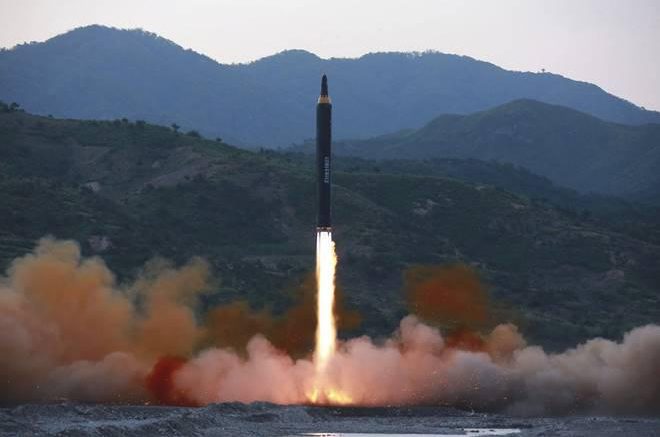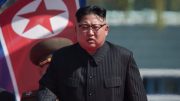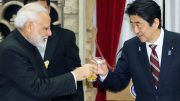North Korea’s second missile launch over Japan in as many months flew far enough to put the U.S. territory of Guam in range, a provocation that comes days after the United Nations approved harsher sanctions against Kim Jong Un’s regime. The intermediate-range missile fired from Pyongyang at 6:57 a.m. on Friday flew over the northern island of Hokkaido, reaching an altitude of 770 kilometers (478 miles) before landing in the Pacific Ocean. It traveled 3,700 kilometers — further than the 3,400 kilometers from Pyongyang to Guam, which North Korea has repeatedly threatened. “The range of this test was significant since North Korea demonstrated that it could reach Guam with this missile, although the payload the missile was carrying is not known,” David Wright, a co-director of the Union of Concerned Scientists, wrote in a blog post.
North Korea, which has fired more than a dozen missiles this year, had pledged to retaliate after the UN Security Council punished the country for its sixth and most powerful nuclear test on Sept. 3. Investors largely shrugged it off on Friday, showing that financial markets are growing accustomed to North Korea’s provocations and the responses of the U.S. and its allies. U.S. President Donald Trump was briefed on the missile launch but made no mention of North Korea in remarks at a White House dinner on Thursday night. The president has said all options — including military — are on the table to stop North Korea from obtaining the ability to strike the U.S. with a nuclear weapon, and has questioned the usefulness of talks.
“These continued provocations only deepen North Korea’s diplomatic and economic isolation,” U.S. Secretary Rex Tillerson said in a statement. He reiterated a call for China and Russia to take action against the rogue state, saying: “China supplies North Korea with most of its oil. Russia is the largest employer of North Korean forced labor.”
On Monday, the UN Security Council approved new sanctions after the U.S. dropped key demands such as an oil embargo to win support from Russia and China, both of which can veto any proposals. The resolution seeks to limit oil imports, ban textile exports and increase inspections of ships suspected of carrying cargo in breach of sanctions.
The council plans to convene on Friday in New York at 3 p.m. local time. China’s foreign ministry didn’t respond to faxed questions about the latest North Korea missile launch.
On Thursday, North Korea had threatened to sink Japan “into the sea” with a nuclear strike and turn the U.S. into “ashes and darkness” for agreeing to the latest UN sanctions.
“We are in an ever worsening cycle of escalation and time is on North Korea’s side,” said Daryl Kimball, executive director of the Washington-based Arms Control Association, who said the country’s technicians are getting better. “So long as the war of words continues and the lack of communications continues, there is an increasing risk that one side or another miscalculates and we have a situation that can lead to military conflict.”
South Korean President Moon Jae-in used his strongest language yet to condemn the latest test. “We have the power to smash North Korea into powder and put it beyond recovery if it provokes us or our alliance,” he said before chairing a National Security Council meeting.
South Korea’s military said it simultaneously conducted a drill in which it fired a ballistic missile into the East Sea, also known as the Sea of Japan.
Japan didn’t try to shoot down the North Korean missile on Friday, and the situation similar to when a missile fired over the country on Aug. 29, government spokesman Yoshihide Suga told reporters. North Korea had called that test a “meaningful prelude” to containing Guam, and threatened to launch more missiles over Japan into the ocean.
In July, North Korea fired two intercontinental ballistic missiles on steep trajectories into the sea between the Korean peninsula and Japan. The regime said those launches put the entire U.S. in its range.
Japanese Prime Minister Shinzo Abe said a unified international response against North Korea needed now more than ever, reiterating that the isolated nation had “no bright future” if it continues on its current path.
Market Reaction
Japan’s benchmark Topix index rose slightly in morning trading in Tokyo, while the yen pared gains spurred by news of the launch. The cost of insuring five-year South Korean sovereign bonds rose the most in a week.
“I wouldn’t necessarily say this is an escalation,” said James Soutter, a portfolio manager at K2 Asset Management in Melbourne. “This is more of a continuance of provocation. Hence markets won’t like it, but I don’t think it’s necessarily the precursor to a sustained market pullback.”
North Korea’s first nuclear test since Trump took office a “perfect success” and confirmed the precision and technology of the bomb, according to the Korean Central News Agency. Kim claimed that his regime could mount a hydrogen bomb onto an ICBM.
While North Korea’s ICBM threat is growing, the U.S. military says it’s not yet imminent. Kim’s regime has yet to demonstrate that it can accurately guide a long-range missile to a target with a nuclear warhead that survives the trip, General Paul Selva, the No. 2 U.S. military official said in a statement to Bloomberg last month.
“A full-out ICBM test could have really rattled the international community as a whole, so they decided to respond to the recent UN sanctions this way,” said Harry J. Kazianis, director of defense studies at the Center for the National Interest in Washington. “They could have been testing improvements in engine design or the reentry vehicle.”





Be the first to comment on "North Korea puts Guam in range with missile launch over Japan"